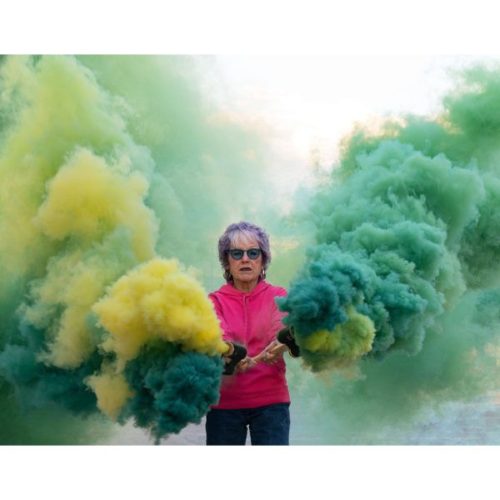Judy Chicago (b. 1939) stands as one of the most important artists to emerge from the feminist movement in the United States. Her work as an artist, writer, and educator pioneered a revolution in the teaching of art, broke new ground in writing about the concerns and process of the artist and forged an essential iconography of abstraction embodying women’s physical and emotional realities. Drawn from the collection of Jordan D. Schnitzer and his family foundation, the exhibition charts a course through Chicago’s career that defines key moments in her personal evolution as an artist and highlights her undeniable influence internationally on the discourse of art, identity, and the construction of gender today.
The exhibition traces Chicago’s development as an artist, activist, and Jewish woman across six decades, from her early formal vocabulary of geometric color abstraction and the pyrotechnic Atmospheres through her trailblazing development of a then-radical lexicon of vaginal or central core imagery, which culminated in the landmark The Dinner Party (1979). Chicago’s continuing explorations of self-identity are evident in works that consider the power politics of the construction of gender and the formative experiences of women –menstruation, pregnancy, and childbirth — in The Birth Project (1980-85); men’s abuse of power; and the Holocaust Project: From Darkness to Light (1885-1993).
Independent and uncompromising, Chicago has spent a lifetime working to empower women artists to liberate themselves from male domination and control. She has enlarged the historic subjects of art through a woman’s perspective, and consistently produced daring, often controversial works that fearlessly confront the power dynamics of representation, validated art as diary, erotic self-expression, and pushed autobiography to new heights.
The power of Judy Chicago’s art is centered in the integration of rigorous formal means with the emotional, intellectual dialectics of identity and feminism. Her groundbreaking use of color systems based in emotion and abstract form to translate female core identity and sexuality into powerful iconography brought her national and international attention. She harnessed the clarity of geometry with the power of color to develop a symbolic vocabulary of women’s collective identity and intimate personal reference to create iconic works of transcendent beauty.
“A NICE JEWISH GIRL FROM CHICAGO”
— Judy Chicago, 2018
Judy Chicago’s over half-century of feminist art practice is legendary. Less familiar is the influence that her Jewish identity plays in her work. Born in Chicago (1939), she grew up in a politically liberal household notable for its esteem of Jewish learning and scholarship coupled with activism. Her father, Arthur Melvin Cohen, descended from a long line of rabbis. Chicago writes about his social idealism and deeply felt belief in tikkun olam — repairing the world. Her mother, May Levinson, similarly championed left-leaning secular causes. Chicago recalls experiencing antisemitism from both students and teachers, despite attending a high school with other Jewish students.
Judy Chicago approaches her Jewish identity with the same fierceness, nerve, and aplomb with which she confronts her art. Her tenacious capacity to evolve was already evident in 1970 when she took out a full-page advertisement in Artforum to publicly renounce patriarchy and to repudiate her married name of Gerowitz. Nor did she return to Cohen, her birth name, which signifies descent from the ancient priesthood and is considered to be one of the most revered names in Judaism. Instead, she adopted the name of “Chicago,” her birthplace. As her biographer Gail Levin notes, this action echoed the choice of geographical surnames that Jews favored after their emancipation in 19th-century Europe.
Judy Chicago continues to evolve in complexity, exultantly suffusing her work with her gender, sexuality, and Jewishness. Her legacy in the history of art validates the fullness of her identify as an artist, writer, woman, and Jew.
“YOU HAVE TO CHOOSE HOPE”
— Judy Chicago, 2019
Judy Chicago animates her work by embodying a feminist perspective within Jewish life. She questions gender stereotypes with uncompromising candor, exposing the ways in which women have been suppressed, marginalized, and erased. The Dinner Party (1979) reveals her feminist reading of the Passover seder that links the struggle of women to achieve freedom and dignity to the journey of Jews from slavery to liberation. In the Birth Project (1980-1985) Chicago celebrates birth, re-envisioning the story of Genesis by confronting “the notion of a male god creating a male human being with no reference to women’s participation in this process.” She collaborated with more than 150 needleworkers, a practice that recalls earlier generations when Jewish women customarily embroidered Jewish ceremonial pieces.
In the mid-1980s, Chicago delved even more deeply into her Jewish heritage. Her intense research subsequently spurred her to align the atrocities of the Holocaust with other forms of injustice, observing that “history has excluded the experiences not only of women but of most of the human race.” This led to the Holocaust Project: From Darkness into Light, completed in 1993, in which Chicago and her husband, photographer Donald Woodman, tie the Nazi destruction of European Jewry to ongoing universal inequalities. In Voices from the Song of Songs (1999), she incorporates an ancient Biblical text to explore the mutual passion between sexes.
A powerful writer, Chicago has used autobiography as a tool of self-discovery and empowerment as a Jewish woman. The artist has recently released The Flowering: The Autobiography of Judy Chicago, a third summarizing edition of her autobiography which began with the landmark Through the Flower: My Struggle as a Woman Artist in 1975.
Throughout her writing and work, Judy Chicago embraces the Jewish belief in hope for a better future. Driven both by moral and political resolve, she stands as an agent of hope in a world constantly threatened by despair; a world where justice triumphs.
